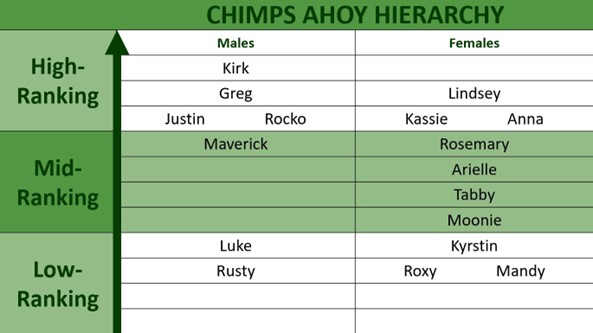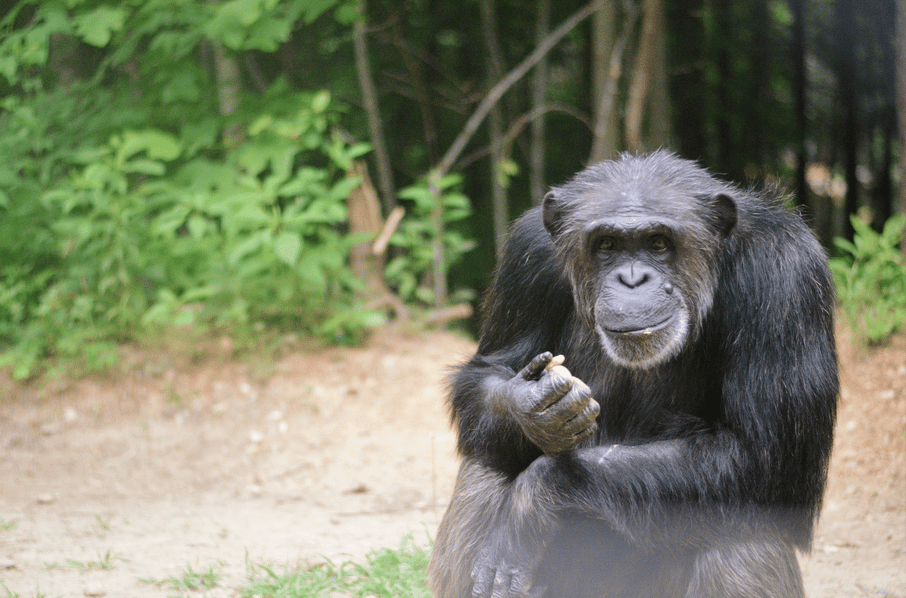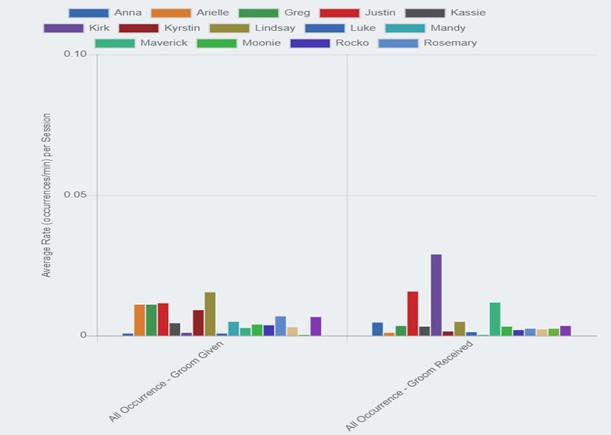
Chimps Ahoy: Hierarchy and Roles – Part 2 of 3

By Devyn Schaefer
Missed Part 1? Read it here.
The Chimps Ahoy group was really fun to watch! A majority of my time was spent watching a lot of grooming and napping—the two most common affiliative behaviors. This may seem like an uneventful behavior to some, but I got plenty of information on the relationships that the chimps had with each other.

When chimps got involved in conflicts, this helped me understand each chimp’s level of dominance and support and how those factors influenced hierarchy. Above is an illustration of the Chimps Ahoy hierarchy (based on my observations, ZooMonitor data, and discussion with Chimps Ahoy caregivers Jake and Kalli) that was organized from the collective understanding of each chimp’s dominance and relationships—which I will now explain.
Affiliative Behaviors: Grooming Time is Useful
Other than making sure they stay clean; chimps will groom one another to strengthen their bonds. According to my data from ZooMonitor, Kirk received the most grooms! Which makes sense considering he is currently the alpha. Every chimp would, of course, want a good relationship with him.

Lindsey gave the most grooms. She was seen grooming multiple chimps—which could be a reason as to why she is considered the alpha female. Because she grooms various chimps, this gives her the support to have such a high ranking due to the many relationships she shares within her group.
Justin was about equal in the amount he gave and received grooms. Although I watched many chimps groom him, Justin mainly focused his grooming efforts to Kirk—which showed his motivation to have a good relationship with the alpha. The chimps that had the lowest grooming interaction overall were Rocko, Luke, Rusty, Roxy, and Mandy. This told me that most of them were lower in hierarchy, but not Rocko. Even though Rocko rarely received or gave grooms, his personality was too dominant to be low ranking.

Affiliative Behaviors: Nap Times Are Also Useful!
When chimps are not grooming, playing, or fighting, they will nap in their favorite spot. That spot may be in a specific place or may be with a certain chimp!
I never found Kirk napping alone. He was commonly found relaxing with Rocko and Justin nearby. Whenever Kirk moved to a different spot, Rocko and Justin would usually follow behind. Other chimps that were commonly seen together during down time were Roxy and Kyrstin. As for favorite napping places, Luke loved to nap next to the window in left bedroom and Rusty’s spot was on the second level in middle bedroom.
Neither Luke nor Rusty cared if they were alone or had chimps nap next to them, they just liked being in their spot. What I learned from naptime was where they preferred to be and who they preferred to be with—which then helped me understand their hierarchy a bit better. Rocko and Justin consistently preferred to be next to Kirk to represent their higher position. Roxy and Kyrstin were lower ranking young females that like to be together for comfort. Luke and Rusty were also lower ranking males as they liked to nap alone but did not mind having company.
Aggressive Behaviors: Conflicts Are the Most Useful!!
Being social creatures, it is important for conflicts to occur. These help the group not only figure out their own politics but understand and learn about each other as well (communication is very important for chimps!). It was not too common for a conflict to occur among the Chimps Ahoy group. But when a fight did happen, this told me a lot about their hierarchy: who is more dominant than the other and who has stronger relationships.
Depending on who instigates whom, the conflict can be between just those two chimps or more can join in to back up one another. It all depends on the social dynamics of hierarchy!

For example, the usual reason for a conflict to happen would be over food. There was one afternoon I watched a caregiver give the chimps their fruit for dinner. Kyrstin was given her fruit with Rocko, Roxy, and Greg nearby. Rocko, being a more dominant chimp than Kyrstin, threatened her to show how much higher ranking he was over Kyrstin as she took her fruit from the caregiver.
Kyrstin fear-grimmaced and then Roxy defended Kyrstin by contact aggressing on Rocko. Because Roxy has a strong relationship with Kyrstin, this is why she chose to pick a fight against such a high-ranking dominant male. Rocko then turned to Roxy to aggress on her, but Kyrstin then backed up Roxy.
A fight broke out between the three. The two young girls soon realized that they bit off more than they could chew, kept their distance from Rocko, and then fear-grimmaced at him together. As Rocko approached the girls, Greg stepped in front of them as a barrier to block Rocko.
Greg is an old chimp that has good relations with the whole group, especially the alpha. At the same time that Greg stepped in, Kirk poked his head through one of the doors and Rocko knew the fight was at an end as it would not have been wise for him to continue. When conflicts like these happened, I looked at how it happened, who sided with who, and how it ended. This helped me understand their complex web of social dynamics and hierarchy.
Want to know more about the politics at Chimps Ahoy? Click on Part 3 to read more about who will become enforcer!

